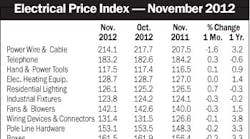Latest from Mag
People - Dec 21, 2012
Obituaries - Dec 21, 2012
November EPI Index Shows No Change
Housing Starts Dip 4% in November
Electrical Marketing - December 21, 2012
Around the Industry - Dec 21, 2012
Editor’s Note: The complete version of this article will appear in the February issue of Electrical Wholesaling.
If you still think Pittsburgh is a soot-stained steel town, think again. Fueled by a downtown renaissance, a more diversified economy and a commitment to green construction, Pittsburgh has not been hit quite as hard by the recession as other metropolitan areas.
If you haven’t been to Pittsburgh in the past 10 years, you would be amazed at all of the new construction. PNC Plaza, soon to be completed, has 780,000 square feet of retail space, offices, parking, condos and a Fairmont Hotel. The project is considered be one of the greenest office towers in the country and was designed to meet Leadership in Energy and Environmental Design (LEED) standards for green buildings. Not too far away is the construction site for Consol Energy Center, the new Pittsburgh Penguins hockey arena, scheduled to open in 2010.
At one time, the river banks of the Allegheny, Ohio and Monongahela Rivers near the city’s downtown were scarred with rusting remnants of the city’s steel town past. Today, the riverfront area is thriving with projects completed within the last decade. Across the river from downtown are Heinz Field, home to the NFL’s Pittsburgh Steelers and PNC Park, home to the Pittsburgh Pirates baseball club. Both stadiums were completed in 2001. Farther north up the Allegheny River is the David L. Lawrence Convention Center, completed in 2003 and with LEED gold certification, one of the greenest convention centers in the United States.
Steel no longer dominates the Pittsburgh area economy and now accounts for less than 1 percent of jobs, down from 10 percent of the workforce in 1980, according to an article in The New York Times. "The steel companies, what’s left of them, are not busy now but still in existence," says R. Lee Hite, chairman and CEO, The Hite Co., Altoona, Pa. "Many are in northern West Virginia, only 50 miles away from Pittsburgh. The price of steel is way down, so mills are shut down or have cut back for the first quarter of 2009."
Steel production is no longer a major industry in Pittsburgh, agrees Dave Paolicelli, president of Paolicelli Associates Inc., a manufacturers’ rep in Carnegie, Pa. "Most of the massive plants have been torn down to make way for commercial developments such as The Waterfront, a residential, commercial and retail development on the site of the former U.S. Steel plant in Homestead. U.S. Steel has pledged $1 billion for the complete upgrade of their coke-making facility in Clairton, Pa. This project, which will take place over the next seven years, will replace the 50-year-old coke ovens with state-of–the-art ones which will meet current pollution standards. The co-generation plant at this facility will also be upgraded. This is the largest construction project in our area since the Pittsburgh International Airport, which was completed 12 years ago."
Another massive new industrial plant on the drawing board is a $1 billion state-of-the-art hot strip mill in Brackenridge, Pa., that Allegheny Technologies Inc., plans to build. Mark Wilson, a principal and president of Unity Electrical Sales Inc., a manufacturers’ rep in Pittsburgh, says the steel companies have stabilized themselves over the past five years to 12 years. "Now in the recent downturn in the last 90 to 120 days with the credit crunch, the steel industry in general has been affected by that and had some layoffs. But they also have some upgrades."
Diversification is the key to Pittsburgh’s economy. In addition to some large industrial projects completed over the last 10 years, Pittsburgh has had some major construction projects in the health-care and education markets. Also, unlike some other U.S. cities, Pittsburgh has not seen the extreme highs and lows in the housing and commercial markets. "We don’t have the huge spikes and dips in our business like so many other large cities," says Paolicelli. "Many large cities in the country are suffering decline after a few spectacular years. Pittsburgh’s good years are typically just OK in comparison, but our bad years aren’t so severe."
Commercial construction, plunging in most places, is still thriving partly because of big projects like the Rivers Casino and arena for the Penguins hockey team. "The Rivers Casino project is still on track and scheduled to open by the end of 2009," says Paolicelli. "The riverfront beautification in front of the casino should be completed sometime in 2010." A former rail bed along the Monongahela River has been transformed into a trail for bikes and walking, he adds.
Bob Suders, regional operations manager of The Hite Co. , says there is very active construction downtown due to relatively low real estate values and the aging condition of some structures. Some of the big projects scheduled for this year include the August Wilson Museum, a new YMCA building and the renovation of the old YMCA building by Point Park College.
Other large projects in the Pittsburgh market include construction at universities, hospitals and an extension of the city’s light rail system. Bob Smith and Dudley McDonough, principals of Sales Marketing Group Inc., a manufacturers’ rep agency in Pittsburgh, say a Pittsburgh version of Boston’s Big Dig, which will be a tunnel under the Allegheny River, is stalled while it waits for about $800 million in financing.
"This (the extension of the light rail system) is a significant regional investment that will support the revitalized downtown Pittsburgh and North Shore’s residential areas, business districts, educational institutions, entertainment developments and cultural venues in addition to enhancing development opportunities," says Suders of The Hite Co.
Many of the new buildings constructed by universities, banks and hospitals over the past 10 years are LEED certified, says Paolicelli of Paolicelli Associates. In 2008, Forbes Magazine said Pittsburgh was one of the top 10 U.S. green cities, as measured by the number of LEED-certified buildings. "Fortunately, we have been able to participate in the construction of many green buildings," says Paolicelli. "The Children’s Hospital of Pittsburgh and the associated Children’s Hospital Research Center, both completed in 2008, are both green buildings. Now under construction are many other buildings in this category. 3PNC Place and Consol Arena, the new home of the Pittsburgh Penguins, are just two of them."
The city of Pittsburgh recently hired a sustainability director to put in place a green strategy, says Suders of The Hite Co. "Green building is going mainstream and will be a strong growth sector for Pittsburgh’s future," he says.
While housing has slowed, the half-million dollar to million dollar homes are steady, says Wilson of Unity Electrical Sales Inc. "They’re not even hiccupping, but the tract homes have been affected by it here," he says. Wilson says the suburbs with active housing markets include Cranberry Township, north of Pittsburgh going up Interstate 79, and Peters Township, south of the city.
Herm Isenstein, president, DISC Corp., Orange, Conn., forecasts that total sales for electrical distributors in the Pittsburgh metropolitan statistical area are expected to be down more than 11 percent in 2009 to about $530 million. Isenstein said when he updates his forecast for the Pittsburgh market he expects the decline to be even steeper.
Looking six months down the road, Pittsburgh distributors and reps say they are optimistic, but after that, it’s an uncertain picture. "Everyone keeps looking at the papers," says Wilson of Unity Electrical Sales. "Our motto here at Unity is, ‘We can’t influence that. Keep finding new opportunities and just keep selling..."

